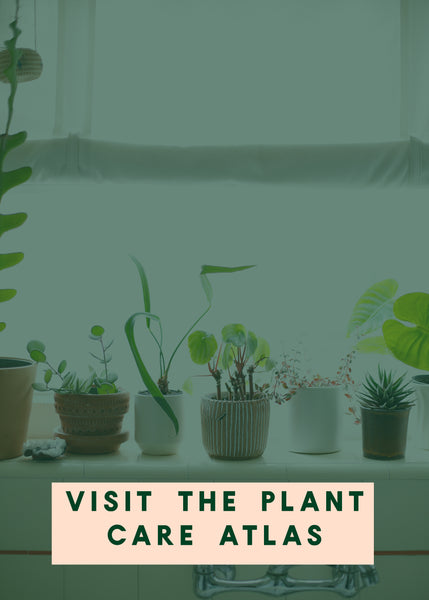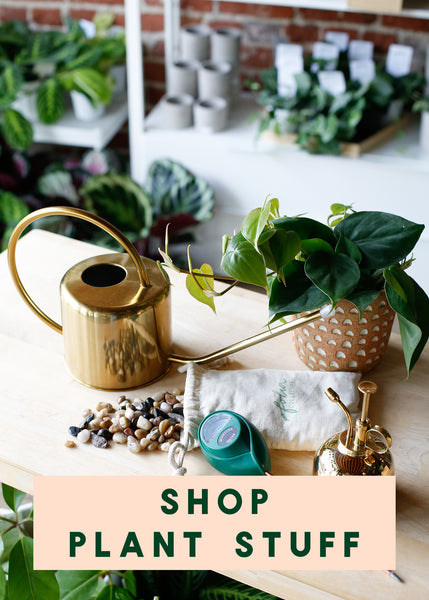Ask A Plant Pro: What Does "Bright Indirect Light" Even Mean? (AKA Understanding Light for Plants)

Every month on our Instagram account we open up a question box for you to submit your plant questions. Think of it like a Dear Abby column but for plant-related questions. If we select your question, we'll send a treat to your Instagram inbox.
Dear Plant Pro,
What the heck does "bright indirect light" mean? I see it on plant care info all the time, but I'm not sure I really know what it is, or whether or not I have it.
-In the dark in Downey
Light is by far the most misunderstood aspect of caring for plants indoors. This is partly due to the fact that light indoors is very different from light outdoors, and the fact that our human eyes are very good at automatically adapting to lower light- which can trick us into thinking an area is brighter than it is. Unfortunately, light is also the MOST IMPORTANT aspect of houseplant care so it will really set you up for more success if you take the time to understand this topic.

There are 3 common terms for light as it relates to houseplants:
Bright Indirect or Bright Filtered
Medium
Low
My favorite way to help explain the difference between these types of light is this- if the plant had eyes, could it see the actual sun, the sky, or neither? The answer will tell you what kind of light you’re dealing with:
Actual sun = Direct sun
Sky = Bright indirect light
Neither = Low light (or maybe medium, depending on how close the plant is to the window)
Keep in mind that most houseplants will do best in bright filtered light, while some can tolerate (but won’t truly thrive in) medium or low light, and others actually need at least some direct sun. The distance a plant is placed from the window will also affect how much light the plant is receiving, so here's a general distance to light type correlation:
0-2 feet = Either direct sun (if the plant can see the actual sun in the sky) or bright indirect (if direct sun is filtered by something like a white semi-sheer curtain, or if only the sky is visible to the plant)
2-5 feet = Either bright indirect (if the area closer to the window receives direct sun) or medium light (if the area closer to the window gets indirect light)
5+ feet = Low light (except in rooms with very large windows that face south or west, in which case this distance may receive medium light)

If you want to dig in deeper to how much light your space gets, a light meter is the most accurate way to really judge the light levels. There are a wide range of light meters available, from this one made specifically for plants by our friend Darryl at House Plant Journal; to ones made for photography; to phone apps like our favorite, Light Meter. With a dedicated light meter, you can get really exact information about how bright a particular spot is, but even if you don't want to go full-light-nerd, a simple light meter app will at least give you an idea of the difference between a bright area in your space and one that might look bright enough.
I encourage people to take light readings in various places- including outside. Comparing these different readings can really open your eyes to how much less light most plants living indoors are getting compared to how much light they'd get in their natural habitat. The difference between the light level directly in front of a window to the corner next to a window will likely shock you (especially since so many people put plants in the corner near a window rather than right in front of the window). What's more, if you're familiar with outdoor gardening terms, you may be surprised to discover the indoor equivalent of terms like "Full Sun", "Full Shade", and "Partial Shade".
Full sun = Direct sun
Full sun outdoors is usually much more intense than direct sun indoors, so plants that require full sun outside, absolutely have to be somewhere they will receive direct sun for at least 4-6 hours indoors.
Full shade = Bright indirect/bright filtered
If you take a light meter reading of a fully shaded area outside, you'll find that the light level is similar to an area indoors that gets very bright filtered light! This is the light most houseplants will do best in and almost any containerized plant you’d keep in full shade outdoors can be kept as a houseplant in bright indirect light indoors.
You'll notice there isn't really an outdoor equivalent to medium/low light (because even shady spots outside have more light than a 'medium' light area indoors)- which should tell you something about how well a plant will do in that kind of light. Though there are some plants that will tolerate it, you'll find that a majority of houseplants do best in brighter light.
So now you may be wondering, "which plants can I put in these different light levels?". Here's a quick guide to the right plants for each level, but if you want a full list, check out our Plant Care Atlas, where you can filter by light levels.

Direct Sun Plants
- Cacti
- Succulents
- Ponytail Palm (Beaucarnea recurvata)
- Euphorbia species
- Yucca species
- Most Carnivorous plants
- Bird of Paradise (Strelitzia species)
- Ceropegia species (String of Hearts, String of Spades, etc)

Bright Indirect Light Plants
- Ficus species (Fiddle Leaf Fig, Rubber Tree, Banyan Tree, Weeping Fig, Ficus Audrey, etc)
- Monstera deliciosa- these will never achieve their more mature form with large leaves and lots of holes/splits without very bright light (and something to climb)
- Wax Plants (Hoya species)
- Most Pilea species-especially Pilea peperomioides- the Chinese Money Plant
- Many Peperomia species
- Dumbcane (Dieffenbachia species)
- Elephant Ear (Alocasia species)
- A majority of other plants commonly kept as houseplants

Medium Light Tolerant Plants
- Chinese Evergreen (Aglaonema species)
- Bird’s Nest Ferns (Asplenium species)
- Green or Golden Pothos (Epipremnum- just not highly variegated varieties like ‘N’Joy’ or ‘Marble Queen’)
- Heartleaf Philodendron (just the solid green P. hederaceum, not the variegated varieties)
- Satin Pothos (Scindapsus pictus ‘Exotica’)
- Dracaena varieties with darker leaves, not the more variegated varieties
Low Light Tolerant Plants
- Snake Plants (Sansevieria species)
- ZZ Plant (Zamioculcas zamiifolia)
Again, keep in mind that other than the ones that need direct sun, nearly all houseplants will do best in bright indirect light. The plants on the medium and low light lists will tolerate lower light, but will only truly thrive in bright light.

Understanding light can be complicated, and there's a lot you can dig into if you want to really go deep, but my if-the-plant-had-eyes test will usually get you in the right realm of understanding what kind of light you can offer a plant and that's a great start to seeing your plants really thrive! If you're interested in learning more, there's an entire chapter of my book, Houseplants For All, dedicated to light. I also recommend the articles on House Plant Journal regarding using a light meter for houseplants if you really want to geek out!





